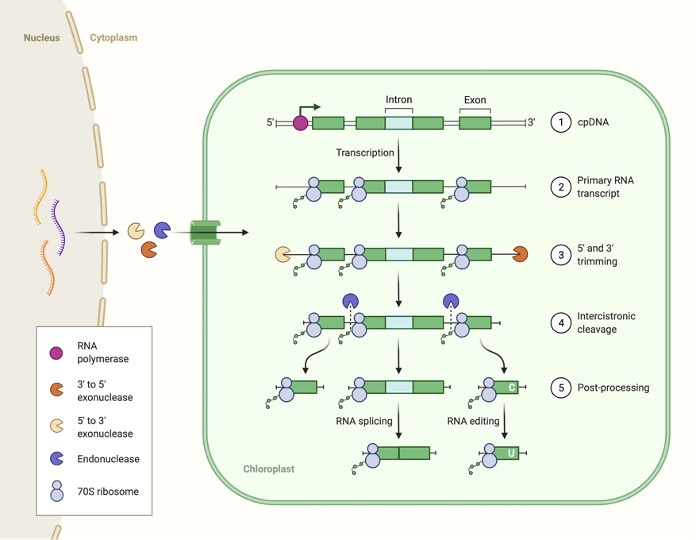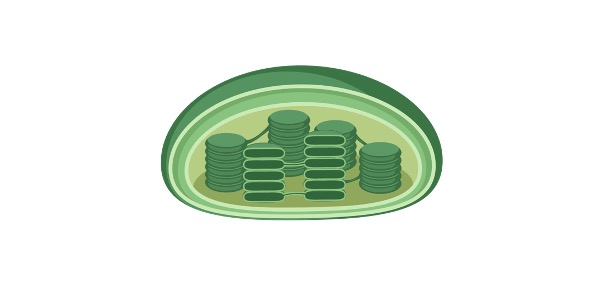Table of Contents
Chloroplast DNA Definition
This genetic material codes for essential RNAs and proteins involved in various metabolic functions like photosynthesis. Chloroplast DNA (cpDNA) refers to genetic material comprised within this organelle and is often referred to as the plastosome. Besides the nucleus, mitochondria and chloroplast are the organelles that have their own extranuclear genetic material in the case of eukaryotes.
The extranuclear DNA is similar in structure to the nuclear DNA that is comprised of monomeric units of nucleotides. Nucleotides comprise pentose sugar, phosphoric acid, and a nucleobase. These organic compounds are responsible for inheritance, regulation of expression, and replication.
History of Chloroplast DNA
The DNA in chloroplasts was first discovered during the early 1950s. In 1963, It was Masahiro R. Ishida who along with Ruth Sager first successfully extrapolated chloroplast DNA from the alga, Chlamydomonas. An enriched satellite DNA was also found with a buoyant density of 1,702 gm/cm3 and has a GC content of 39.3%.
Chloroplast DNA Characteristic
Chloroplast DNA is a circular extranuclear DNA, that has about 120 genes and consists of about 120,000-170,000 base pairs. cpDNA molecules have many copies present in each chloroplast. The chloroplast organelle is one of the 3 types of plastids. Leucoplasts and chromoplasts are the other 2 types.
The chloroplasts contain photosynthetic plastids having large quantities of chlorophyll pigment. The chloroplast is a double membraned organelle with 3 membrane systems. The membrane system includes the thylakoid membrane, besides the outer and inner membrane.
The matrix of the chloroplast is referred to as stroma and contains cpDNA, molecules, enzymes, and ions. The dark reactions occur here in this part of the chloroplast. The Chloroplast DNA sequence usually includes 4,000-25,000 bp of inverted repeats, but these are not found in the case of exceptions of certain red algae and pea plants.
Chloroplast DNA vs Mitochondrial DNA
The cpDNA and mtDNA are similar in the fact that they both are semi-autonomous extranuclear cytoplasmic DNA that means they have their genetic material. As they are found in the cytoplasm, they are maternally inherited and their possible origin in the eukaryotic cell can be explained by endosymbiosis as these organelles are circular and have other similarities to a prokaryotic cell.
The chromosomal genetic material is more complex and larger than mtDNA that has only 37 genes. This DNA also codes for RNAs and proteins required by the organelles. For instance, the mt DNA encodes enzymes required for ETC that is essential for ATP synthesis.
Cp DNA codes for enzymes and complexes required in photosynthesis. Both cpDNA and mtDNA have several copies depending on the number of these organelles in the cell may be ranging in thousands. The inheritance pattern of nuclear DNA that has protein histones and chromatin structure differs from mt and cpDNA. During cell divisions as in mitosis and meiosis, during cytokinesis, these organelles are randomly segregated.
Chloroplast DNA Inheritance
This extranuclear cpDNA is inherited maternally and deviates from the Mendelian pattern of inheritance. For instance, Karl Erich Correns a German botanist noticed that some traits were inconsistent with the Mendal laws in Mirabilis jalapa. The same plant he observed had a mixture of leaf colors, as some were variegated while others were white or green.
On fertilizing female flowers from white leaves with male flowers from green leaves, the seeds generated were sown to germinate into a plant containing white leaves showing their maternal inheritance.
Chloroplast Genetic Expression
Cp DNA is circular DNA and its replication occurs by a double displacement loop (D-loop) mechanism. In replication, the parental template strands are separated and from each, a new daughter strand is synthesized.

cpDNAs encodes for rRNAs, ribosomal proteins, tRNAs, and RNA polymerase subunits through transcription and translation. These are required for synthesizing proteins involved in different reactions in the chloroplast. Nuclear DNA encoded RNA polymerase also aids in transcription.
Biological Function of Chloroplast DNA
Chloroplast DNA encodes for tRNAs (about 30-31), 3 rRNAs (23S, 16S, 5S, 4.5S), 4 RNA polymerase subunits, ribosomal proteins (about 21), photosystem I, cytochrome bf complex, photosystem II, the large subunit of rubisco and ATP synthase. These enzymes and complexes are involved in photosynthesis and protein synthesis machinery.
Rubisco enzyme is involved in the reduction and fixation of carbon in the stroma. During the Calvin cycle, it catalyzes the addition of CO2 to ribulose-1,5-bisphosphate. cpDNA also functions in the production of 11 subunits of a complex required for redox reactions to recycle electrons.
In the evolutionary history of the eukaryotic cell, it is hypothesized that some endosymbiotic gene transfers took place. In this process parts of cpDNA were integrated into nuclear DNA leading to a loss in size of cpDNA when compared with cyanobacteria.
Chloroplast DNA Citations
- Chloroplast DNA phylogeography of Clintoniaudensis Trautv. & Mey. (Liliaceae) in East Asia. Mol Phylogenet Evol . 2010 May;55(2):721-32.
- Chloroplast biosystematics: chloroplast DNA as a molecular probe. Biosystems . 1985;18(3-4):299-306.
- Chloroplast DNA Dynamics: Copy Number, Quality Control and Degradation. Plant Cell Physiol . 2018 Jun 1;59(6):1120-1127.
- Figures are created with BioRender.com







